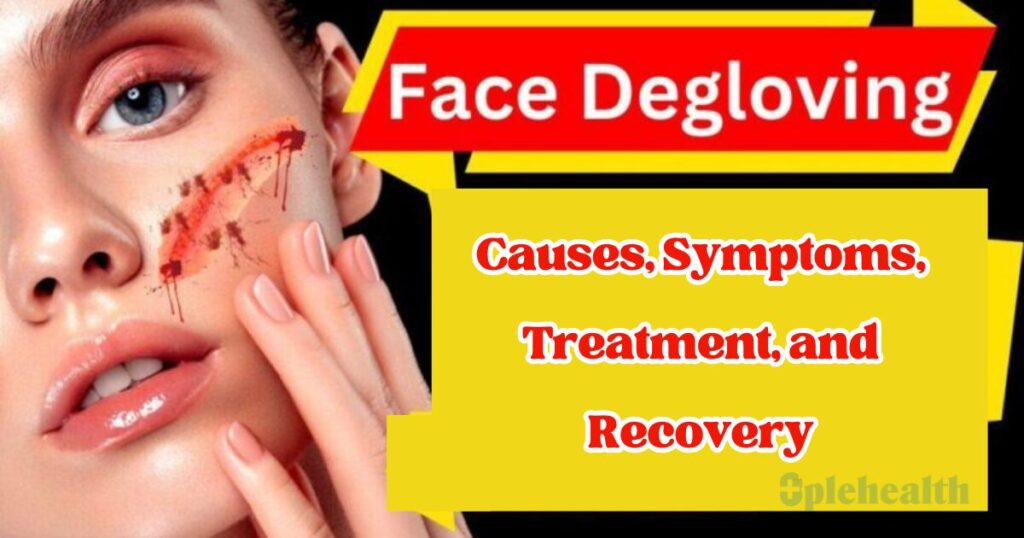A degloved face is a severe and often traumatic injury where the skin and soft tissue are forcefully torn away from the underlying bone, muscles, and connective tissues. This injury can result from various high-impact accidents, such as motor vehicle collisions, industrial accidents, or animal attacks. The nature of a degloved face requires immediate and intensive medical intervention due to the complexity and potential complications involved.
Understanding the severity of facial degloving is crucial for both medical professionals and the general public. This knowledge can significantly impact the approach to treatment and recovery, ultimately improving patient outcomes. This comprehensive guide aims to provide detailed information on the causes, symptoms, treatment options, and recovery processes for a degloved face. Our target audience includes individuals seeking in-depth understanding, medical students, healthcare professionals, and anyone affected by or interested in learning about facial degloving injuries.
Table of Contents
Toggle- Causes of a Degloved Face
- Symptoms of a Degloved Face
- Diagnosis of a Degloved Face
- Immediate Actions to Take if You Have a Degloved Face
- Treatment Options for a Degloved Face
- Surgical Procedures for Treating a Degloved Face
- Recovery Process and Rehabilitation
- Potential Complications and How to Manage Them
- Long-Term Outlook and Quality of Life
- Real-Life Case Studies
- Preventing Degloving Injuries
- Frequently Asked Questions (FAQ) about Degloved Face
- Conclusion
- Call to Action
Causes of a Degloved Face
facial degloving occur due to various high-impact and traumatic events. Understanding the common causes helps in both prevention and quick response in emergencies. Here are the primary scenarios that can lead to a degloved face:
- Car and Motorcycle Accidents: High-speed collisions can cause significant trauma, leading to a degloved face. The force of impact, especially when the head strikes a hard surface or is dragged across the pavement, can result in the skin and underlying tissue being ripped away from the facial bones.
- Industrial or Farm Equipment Accidents: Heavy machinery in industrial and agricultural settings poses a risk for severe injuries, including a degloved face. Incidents involving conveyor belts, grinders, or other powerful equipment can result in the skin being forcefully removed.
- Sports Injuries: Contact sports and extreme activities sometimes lead to accidents causing a degloved face. High-impact sports like rugby, football, or cycling accidents can result in facial degloving due to collisions or falls.
- Falls from Heights: Falling from a significant height can cause a degloved face if the person lands on their face or if the face scrapes against a rough surface during the fall. This type of trauma is often seen in construction accidents or recreational activities like rock climbing.
- Animal Attacks: Attacks by large animals, such as dogs or wild animals, can result in a degloved face. The force of the bite and the subsequent tearing motion can strip the skin and tissue from the facial structure.
- Physical Assaults: Violent assaults involving blunt force trauma or the use of sharp objects can cause a degloved face. Such injuries are often seen in cases of severe physical violence where the face is a target.
Understanding these causes is critical for both preventing such injuries and ensuring timely and appropriate medical responses when they occur.
Symptoms of a Degloved Face
A degloved face presents with several distinct and alarming symptoms. Recognizing these symptoms is crucial for prompt and effective medical intervention. Here are the detailed symptoms to look out for:
- Extreme Pain: One of the most immediate symptoms of a degloved face is severe, excruciating pain. The intensity of pain is often overwhelming due to the extensive damage to the skin, muscles, and nerves.
- Visible Lacerations or Open Wounds: A degloved face will typically have large, gaping wounds where the skin has been torn away. These lacerations are usually irregular and extend deep into the underlying tissues.
- Exposed Bone, Muscle, or Connective Tissue: In a degloved face injury, the detachment of the skin often leaves the bones, muscles, and connective tissues exposed. This exposure increases the risk of infection and complicates the healing process.
- Severe Blood Loss: A degloved face often leads to significant blood loss due to the extensive vascular damage. This symptom necessitates immediate medical attention to control hemorrhaging and stabilize the patient.
- Tissue Death and Necrosis: If a degloved face is not treated promptly, the lack of blood flow can result in tissue death (necrosis). This complication further complicates treatment and may require surgical intervention to remove dead tissue.
- Swelling, Bruising, and Discoloration: In addition to the visible wounds, a degloved face will show signs of severe swelling, bruising, and discoloration. These symptoms are indicative of underlying trauma and inflammation.
These symptoms underscore the severity of a degloved face and highlight the need for immediate and comprehensive medical care. Proper diagnosis and prompt treatment are essential to manage the injury effectively and to minimize long-term damage.
Diagnosis of a Degloved Face
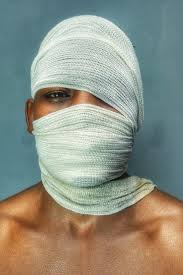
Diagnosing a degloved face is a critical process that involves several steps to ensure an accurate and comprehensive assessment. Key procedures and instruments utilized in the diagnosis are as follows:
- Initial Steps in Diagnosing a Facial Degloving Injury:
- Visual Examination: The first step in diagnosing a degloved face is a thorough visual examination. This allows medical professionals to assess the extent of the injury, identify exposed tissues, and determine the immediate need for intervention.
- Medical History and Incident Details: Gathering information about the incident that caused the degloved face is essential. Understanding the mechanism of injury helps in planning appropriate diagnostic and treatment strategies.
- Role of Medical Imaging in Assessment:
- CT Scans: Computed tomography (CT) scans are crucial in evaluating a degloved face. CT scans provide detailed images of the facial bones and surrounding structures, helping to identify fractures and other internal injuries that may not be visible during a physical examination.
- MRI: Magnetic resonance imaging (MRI) is another important tool in the diagnosis of a degloved face. MRI scans offer detailed views of the soft tissues, including muscles, nerves, and blood vessels, which are critical for planning surgical repair and assessing the extent of soft tissue damage.
- Importance of Early and Accurate Diagnosis:
- Preventing Complications: Early diagnosis of a degloved face is vital to prevent complications such as infection, necrosis, and excessive blood loss. Prompt and accurate assessment ensures that appropriate measures are taken quickly.
- Guiding Treatment Plans: Accurate diagnosis through imaging and physical examination helps in developing a comprehensive treatment plan. This plan may include surgical intervention, wound care, and long-term rehabilitation strategies to restore function and appearance.
The use of advanced medical imaging and thorough initial assessments are key components in the diagnosis of a degloved face, facilitating effective treatment and improving patient outcomes.
Immediate Actions to Take if You Have a Degloved Face
Experiencing a degloved face is a medical emergency that requires immediate attention. Here are the crucial steps to take immediately after the injury:
- First Aid Measures and What to Do Immediately After the Injury:
- Stay Calm: It is important to remain as calm as possible despite the distressing nature of a degloved face. Panic can exacerbate the situation and increase blood loss.
- Apply Pressure: Use a clean cloth or sterile gauze to apply gentle but firm pressure to the wound to help control bleeding. This can be critical in preventing excessive blood loss.
- Protect the Wound: If possible, cover the wound with a clean, non-stick dressing to protect exposed tissues from contamination and further injury.
- Importance of Seeking Emergency Medical Attention:
- Call for Help: Immediately call emergency services for help. Inform them of the severity of the injury to ensure that appropriate medical personnel and equipment are dispatched.
- Transport to Hospital: If emergency services are not readily available, arrange for immediate transportation to the nearest hospital. Do not attempt to drive yourself if you have a degloved face; the shock and pain can impair your ability to do so safely.
- Steps to Prevent Further Damage and Infection:
- Avoid Touching the Wound: Minimize handling of the exposed tissues to reduce the risk of infection and further damage.
- Maintain Cleanliness: Ensure that any materials used to cover or dress the wound are as clean as possible. Avoid using unsterilized materials that can introduce bacteria.
- Elevate the Head: If the person is lying down, slightly elevate the head to reduce swelling and bleeding. This can also help in maintaining airway patency if the degloved face affects breathing.
Taking these immediate actions can significantly impact the outcome for someone with a degloved face, reducing the risk of complications and improving the chances of successful medical intervention and recovery.
Treatment Options for a Degloved Face
Treating a degloved face involves a multi-faceted approach that addresses immediate concerns and long-term recovery. Here is an overview of the treatment strategies:
- Emergency Measures to Control Bleeding and Stabilize the Patient:
- Hemorrhage Control: One of the first steps in treating a degloved face is to control bleeding. This is often done through direct pressure, use of hemostatic agents, and sometimes surgical intervention.
- Stabilization: Ensuring the patient is stable is critical. This may involve intravenous fluids to maintain blood pressure, pain management, and airway protection if the injury affects breathing.
- Surgical Options:
- Reattachment of Skin and Tissue: If the skin and underlying tissues are still viable, surgeons will attempt to reattach them. This process involves meticulous cleaning of the wound, aligning tissues correctly, and securing them with sutures or staples.
- Skin Grafts and Flaps: In cases where the skin cannot be reattached, skin grafts and flaps are used. Skin grafts involve taking healthy skin from another part of the body to cover the wound. Flaps are sections of tissue that include skin, fat, and sometimes muscle, moved from one part of the body to another.
- Reconstruction of Facial Structures: Severe cases of a degloved face might require reconstructive surgery to restore the facial structure. This can include repairing or reconstructing bones, cartilage, and other soft tissues to achieve both functional and aesthetic outcomes.
- Role of Antibiotics to Prevent Infection:
- Preventing Infection: Given the exposure of internal tissues, infection is a significant risk with a degloved face. Broad-spectrum antibiotics are typically administered initially, followed by more targeted antibiotics based on wound cultures.
- Pain Management Techniques:
- Medication: Effective pain management is essential for patients with a degloved face. This often involves a combination of analgesics, including opioids for severe pain, and non-opioid pain relievers.
- Non-Pharmacological Methods: In addition to medication, techniques such as cold compresses, elevation of the affected area, and other supportive measures can help manage pain and reduce inflammation.
Each of these treatment components is crucial for addressing the immediate and long-term challenges associated with a degloved face, ensuring the best possible recovery and quality of life for the patient.
Surgical Procedures for Treating a Degloved Face
Treating a degloved face involves several intricate surgical procedures designed to restore both function and appearance. Here are the detailed explanations of common surgical procedures used in such cases:
- Debridement and Cleaning of the Wound:
- Debridement: The first surgical step in treating a degloved face is thorough debridement. This process involves removing all dead, damaged, and contaminated tissue from the wound. Debridement is essential to prevent infection and to prepare the wound for further reconstruction.
- Wound Cleaning: After debridement, the wound is meticulously cleaned using sterile solutions. This helps to reduce the bacterial load and further lowers the risk of infection.
- Reattachment and Repositioning of Skin and Tissues:
- Skin Reattachment: If the skin and underlying tissues are still viable, surgeons attempt to reattach them. This involves careful alignment of the tissues to their original anatomical positions and securing them with sutures, staples, or adhesive strips.
- Repositioning of Tissues: In some cases, tissues may need to be repositioned to cover exposed areas and to ensure that the vascular supply to the tissues is maintained.
- Use of Local and Distant Flaps for Reconstruction:
- Local Flaps: Local flaps involve using nearby skin and tissue to cover the wound. These flaps are rotated or moved from adjacent areas while maintaining their original blood supply. This technique is commonly used when the affected area is relatively small.
- Distant Flaps: For larger wounds or when local tissues are insufficient, distant flaps are used. These involve transferring tissue from another part of the body to the face. This can be done using pedicled flaps (which remain partially attached to their original site) or free flaps (which are completely detached and then reattached using microsurgery to connect blood vessels).
- Staged Surgeries and Long-Term Planning:
- Staged Surgeries: Complex cases of a degloved face often require multiple surgeries over time. Initial surgeries focus on stabilizing the patient and addressing the most critical issues, while subsequent surgeries aim at fine-tuning the reconstruction and improving both function and aesthetics.
- Long-Term Planning: Long-term treatment plans are essential for patients with a degloved face. These plans involve ongoing assessments and adjustments to the surgical approach based on the patient’s healing progress and functional needs. Rehabilitation, including physical therapy and psychological support, is also a critical component of long-term care.
These surgical procedures are fundamental to the successful treatment of a degloved face, emphasizing the need for a meticulous and staged approach to restore the patient’s appearance and functionality.
Recovery Process and Rehabilitation

Recovering from a degloved face injury is a complex and lengthy process that involves several stages. Here is a detailed look at the timeline and components of recovery:
- Timeline and Stages of Recovery from a Degloved Face Injury:
- Immediate Post-Surgery Phase: In the first few days to weeks after surgery, the focus is on wound healing, infection prevention, and pain management. Patients are closely monitored in a hospital setting.
- Intermediate Phase: Over the next few weeks to months, patients begin to see the initial results of surgical repairs. This stage involves continued wound care and the gradual initiation of physical therapy.
- Long-Term Recovery: Full recovery from a degloved face can take several months to years. During this time, additional surgeries may be performed to improve function and appearance. Long-term monitoring is essential to address any complications that arise.
- Physical Therapy and Rehabilitation Requirements:
- Facial Exercises: Physical therapy for a degloved face often includes specific exercises to improve facial muscle function and prevent stiffness. These exercises help in regaining facial expressions and normal movement.
- Scar Management: Techniques such as massage, silicone gel sheets, and laser therapy are used to minimize scarring and improve the appearance of the skin.
- Speech and Swallowing Therapy: If the injury affects the mouth and throat, speech and swallowing therapy may be necessary to help patients regain these essential functions.
- Importance of Follow-Up Care and Monitoring for Complications:
- Regular Check-Ups: Consistent follow-up appointments with healthcare providers are crucial for monitoring the healing process and detecting any early signs of complications, such as infection, tissue necrosis, or graft rejection.
- Imaging and Blood Tests: Periodic imaging studies and blood tests may be required to assess the internal healing and to ensure that the body is responding well to the surgical interventions.
- Psychological Impact and Support:
- Emotional Trauma: A degloved face can have a profound psychological impact, leading to conditions such as post-traumatic stress disorder (PTSD), depression, and anxiety. Addressing these issues is a critical component of the recovery process.
- Counseling and Support Groups: Psychological support through counseling and participation in support groups can help patients cope with the emotional and mental challenges of their injury. Peer support from others who have experienced similar injuries can be particularly beneficial.
- Body Image and Self-Esteem: Reconstructive surgeries and rehabilitation efforts aim to improve the patient’s appearance, but emotional support is also needed to help them adjust to changes in their body image and to rebuild self-esteem.
The recovery process for a degloved face is multifaceted, involving both physical and psychological rehabilitation to help patients regain their quality of life.
Potential Complications and How to Manage Them
Managing a degloved face involves being vigilant about potential complications that can arise during the healing process. Here are the common complications and strategies to minimize and manage them:
- Infections:
- Risk Factors: Due to the extensive exposure of tissues, a degloved face is highly susceptible to infections. Contaminants from the injury event or during initial treatment can introduce bacteria into the wound.
- Management Strategies:
- Antibiotics: Prompt administration of broad-spectrum antibiotics can help prevent bacterial infections. Antibiotics may be adjusted based on wound culture results.
- Wound Care: Regular and meticulous wound cleaning and dressing changes are essential to keep the area sterile and to promote healing.
- Monitoring: Continuous monitoring for signs of infection, such as increased redness, swelling, or pus discharge, allows for early intervention.
- Necrosis:
- Risk Factors: Necrosis, or tissue death, can occur if the blood supply to the affected tissues is compromised. This is a significant risk in severe degloving injuries.
- Management Strategies:
- Debridement: Regular debridement procedures to remove necrotic tissue help prevent the spread of necrosis and prepare the wound for further healing.
- Revascularization: Surgical techniques to restore blood flow to the affected areas can reduce the risk of tissue death. This may include microvascular surgery to connect blood vessels.
- Hyperbaric Oxygen Therapy: In some cases, hyperbaric oxygen therapy can be used to enhance tissue oxygenation and promote healing.
- Scarring and Contractures:
- Risk Factors: Extensive wounds from a degloved face often result in significant scarring. Scar tissue can lead to contractures, where the skin tightens and restricts movement.
- Management Strategies:
- Scar Management: Treatments such as silicone gel sheets, steroid injections, and laser therapy can reduce scar formation and improve skin elasticity.
- Physical Therapy: Regular physical therapy exercises help maintain flexibility and prevent contractures. This includes specific stretching and movement exercises for the facial muscles.
- Surgical Interventions: In severe cases, surgical procedures such as Z-plasty or skin grafts may be required to release contractures and improve function.
- Nerve Damage:
- Risk Factors: The trauma involved in a degloved face can damage facial nerves, leading to loss of sensation or motor function.
- Management Strategies:
- Nerve Repair: Surgical techniques to repair or graft damaged nerves can help restore function. It is essential to intervene early for the best results.
- Rehabilitation: Occupational and physical therapy focusing on facial exercises can aid in regaining nerve function and improving muscle control.
- Pain Management: Managing neuropathic pain through medications, such as anticonvulsants and antidepressants, and non-pharmacological methods, like nerve blocks, can improve the patient’s quality of life.
Managing these complications requires a multidisciplinary approach, combining surgical, medical, and rehabilitative strategies to ensure the best possible outcomes for patients with a degloved face.
Long-Term Outlook and Quality of Life
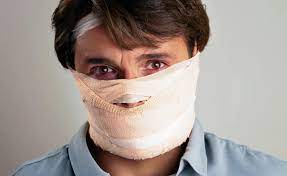
The long-term outlook for patients with a degloved face depends on various factors, including the severity of the injury, the effectiveness of the initial treatment, and the ongoing care and support received. Here are key aspects of the long-term outcomes and quality of life considerations:
- Expected Long-Term Outcomes for Patients with a Degloved Face:
- Functional Recovery: With appropriate medical intervention, many patients can achieve significant functional recovery. This includes regaining the ability to perform essential facial movements, such as blinking, smiling, and speaking.
- Aesthetic Results: The appearance of the face post-reconstruction varies based on the extent of the injury and the success of reconstructive surgeries. While scars and some deformities might remain, modern surgical techniques can substantially improve the visual outcome.
- Role of Reconstructive Surgery in Improving Appearance and Function:
- Initial Reconstruction: The first stage of reconstructive surgery aims to repair the most critical aspects of the injury, such as reattaching skin and stabilizing facial structures. This is crucial for restoring basic functions and preventing further damage.
- Secondary Surgeries: Subsequent surgeries may focus on refining the results of the initial reconstruction. This can involve procedures to enhance symmetry, reduce scarring, and improve the overall aesthetic appearance of the degloved face.
- Advanced Techniques: Techniques such as microvascular surgery, tissue expansion, and the use of synthetic implants or grafts can significantly enhance both function and appearance. These methods are tailored to address specific needs and optimize outcomes for each patient.
- Quality of Life Considerations and Support Systems:
- Emotional and Psychological Support: The psychological impact of a degloved face can be profound. Access to mental health services, including counseling and support groups, is essential for helping patients cope with changes in their appearance and function. Family and friend support is also highly important for healing.
- Social and Vocational Rehabilitation: Programs aimed at reintegrating patients into their social and work environments are vital. This might include job training, social skills development, and adaptive strategies to help patients resume their daily activities.
- Ongoing Medical Care: Regular follow-up appointments with a multidisciplinary team of healthcare providers ensure that any complications are promptly addressed. This team may include plastic surgeons, dermatologists, physical therapists, and mental health professionals.
Long-term outcomes for patients with a degloved face are greatly influenced by the comprehensive care and support they receive. While challenges persist, advancements in medical treatments and reconstructive techniques offer hope for improved functionality and quality of life.
Real-Life Case Studies
Studying real-life cases of degloved face injuries provides valuable insights into the treatment approaches and outcomes. Here are three examples that illustrate the complexity and varied outcomes of such injuries:
- Case Study 1: Motor Vehicle Accident:
- Incident: A 35-year-old male was involved in a high-speed car accident, resulting in a severe degloved face.
- Treatment Approach:
- Emergency Measures: The patient was immediately transported to a trauma center where bleeding was controlled, and initial wound cleaning was performed.
- Surgical Interventions: Multiple surgeries were conducted, starting with debridement and reattachment of viable tissues. Skin grafts were used for areas where the skin could not be reattached.
- Rehabilitation: The patient underwent extensive physical therapy to restore facial movements and speech therapy to address difficulties in speaking.
- Outcome: After a year of treatment, the patient regained most of his facial functions. Scarring remained visible, but reconstructive surgeries significantly improved his appearance.
- Lessons Learned: Early and aggressive intervention, combined with a multidisciplinary approach, is crucial for favorable outcomes in severe degloved face injuries.
- Case Study 2: Industrial Accident:
- Incident: A 28-year-old female sustained a degloved face when her scarf was caught in industrial machinery.
- Treatment Approach:
- Immediate Care: First responders applied pressure to control bleeding and transported her to the hospital. Initial surgery involved cleaning the wound and partial reattachment of the skin.
- Advanced Reconstruction: Over the next six months, the patient underwent several reconstructive surgeries, including the use of free flaps to restore the contour and function of her face.
- Psychological Support: The patient received psychological counseling to cope with the trauma and body image changes.
- Outcome: Functional recovery was achieved, with the patient returning to work after a year. Psychological support was essential in helping her adjust to her new appearance.
- Lessons Learned: The integration of psychological support with medical treatment is vital for comprehensive recovery in degloved face injuries.
- Case Study 3: Animal Attack:
- Incident: A 40-year-old male was attacked by a dog, resulting in a degloved face with extensive soft tissue damage.
- Treatment Approach:
- Initial Management: Emergency treatment focused on stopping the bleeding and preventing infection. Broad-spectrum antibiotics were administered immediately.
- Surgical Repair: The patient underwent a series of surgeries, starting with debridement and progressing to the use of local and distant flaps for facial reconstruction.
- Long-Term Care: Follow-up care included regular check-ups, scar management therapies, and physical therapy to improve facial mobility.
- Outcome: The patient achieved significant functional and aesthetic recovery, though minor asymmetry remained. Continuous follow-up and minor corrective surgeries helped improve results over time.
- Lessons Learned: Timely antibiotic administration and a well-coordinated surgical plan are key to preventing complications and achieving good outcomes in degloved face cases.
These case studies highlight the importance of a comprehensive treatment approach involving emergency care, advanced surgical techniques, and long-term rehabilitation. Each case underscores the critical role of early intervention and multidisciplinary care in managing degloved face injuries effectively.
Preventing Degloving Injuries
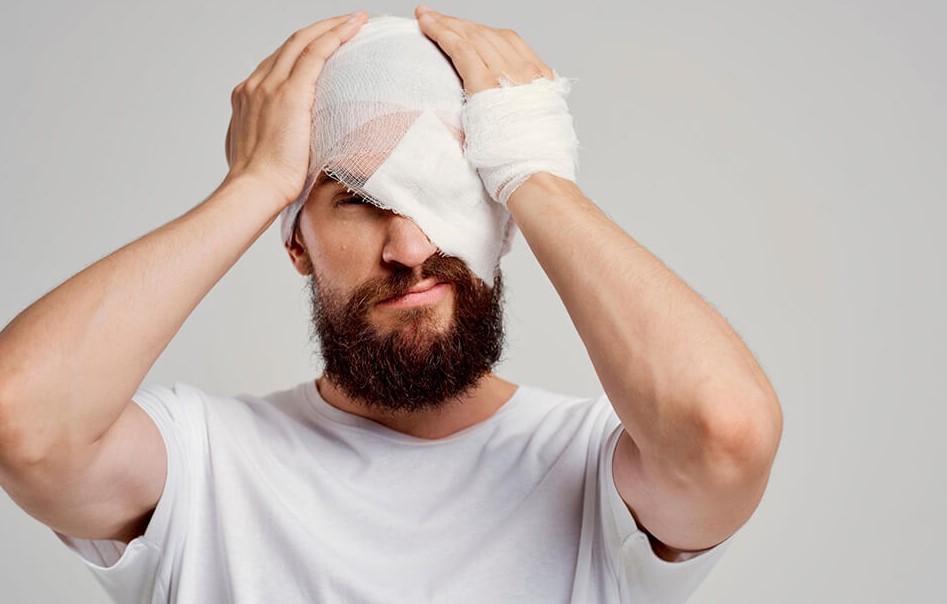
Preventing a degloved face involves taking proactive measures to reduce the risk of such traumatic injuries. Here are some safety tips and measures that can help prevent facial degloving injuries:
- Wearing Protective Gear During High-Risk Activities:
- Helmets and Face Shields: When engaging in activities such as motorcycling, bicycling, and certain sports, wearing helmets with face shields can significantly reduce the risk of a degloved face.
- Protective Clothing: Using appropriate protective clothing, including full-face helmets and impact-resistant masks, can protect the face from high-impact injuries.
- Workplace Safety Protocols:
- Safety Training: Employers should provide comprehensive safety training for workers, especially those operating heavy machinery or working in hazardous environments. Understanding the proper use of equipment and emergency procedures can prevent accidents that lead to a degloved face.
- Protective Equipment: Mandating the use of personal protective equipment (PPE) such as face guards, safety goggles, and hard hats can mitigate the risk of facial injuries in the workplace.
- Safe Driving Practices:
- Seat Belts: Always wearing seat belts while driving or riding in a vehicle can prevent severe injuries during accidents, including a degloved face.
- Airbags: Ensuring that vehicles are equipped with functional airbags and maintaining them can provide an additional layer of protection in collisions.
- Avoiding Distractions: Practicing safe driving habits, such as avoiding distractions like texting and driving, can reduce the likelihood of accidents.
- Avoiding Risky Behaviors and Situations:
- Risk Assessment: Being aware of the risks associated with certain activities and avoiding unnecessary hazards can prevent accidents. For instance, avoiding standing too close to machinery in operation or engaging in high-risk behaviors can minimize the risk of a degloved face.
- Supervision and Guidance: Ensuring that children and inexperienced individuals are supervised and guided when engaging in potentially dangerous activities can prevent injuries.
Implementing these safety measures and maintaining a proactive approach to risk management can significantly reduce the occurrence of a degloved face and other severe injuries.
Frequently Asked Questions (FAQ) about Degloved Face
What should I do immediately after sustaining a degloving injury?
If you sustain a degloved face, immediate action is crucial:
- Stay Calm: Try not to become agitated or panicked.
- Control Bleeding: Use sterile gauze or a clean cloth to gently press on the bleeding area.
- Protect the Wound: Cover the wound with a clean, non-stick dressing if possible.
- Seek Emergency Help: Call emergency services immediately or get to the nearest hospital as quickly as possible. Inform medical personnel about the severity of the injury.
How much time does a degloved face take to heal?
The recovery time for a degloved face varies based on the severity of the injury and the treatments received. Typically, the recovery process can take several months to years and involves:
- Initial Healing: The first few weeks to months focus on wound healing and initial surgeries.
- Rehabilitation: Ongoing physical therapy and additional surgeries may be needed over the next year or more.
- Long-Term Care: Continuous follow-up care to manage scars and prevent complications is essential.
What are the chances of complete recovery?
The chances of complete recovery from a degloved face depend on several factors:
- Severity of the Injury: More severe injuries with extensive tissue loss may have more complicated recoveries.
- Prompt Medical Attention: Immediate and effective medical intervention improves the chances of recovery.
- Reconstructive Success: The success of surgical and rehabilitative efforts significantly influences recovery outcomes. While some patients achieve near-complete recovery, others may experience lasting scars or functional impairments.
Can degloving injuries be prevented?
Yes, degloving injuries can be prevented by taking safety precautions:
- Wear Protective Gear: Use helmets, face shields, and appropriate protective clothing during high-risk activities.
- Follow Safety Protocols: Adhere to workplace safety guidelines and use personal protective equipment.
- Practice Safe Driving: Always wear seat belts, avoid distractions, and ensure vehicles are equipped with airbags.
- Avoid Risky Behaviors: Be cautious around machinery, avoid unnecessary hazards, and ensure proper supervision in potentially dangerous situations.
What sort of support will I require while I’m recovering?
Recovering from a degloved face requires comprehensive support:
- Medical Care: Regular follow-up visits, potential additional surgeries, and ongoing treatments for wound care and scar management.
- Physical Therapy: Exercises to restore facial movement, improve muscle function, and prevent contractures.
- Psychological Support: Counseling and support groups to help cope with the emotional impact of the injury.
- Social and Vocational Rehabilitation: Assistance in reintegrating into social activities and returning to work, including adaptive strategies and job training.
These FAQs address common concerns and provide guidance for patients and families dealing with a degloved face, ensuring they are well-informed and supported throughout the recovery process.
Conclusion
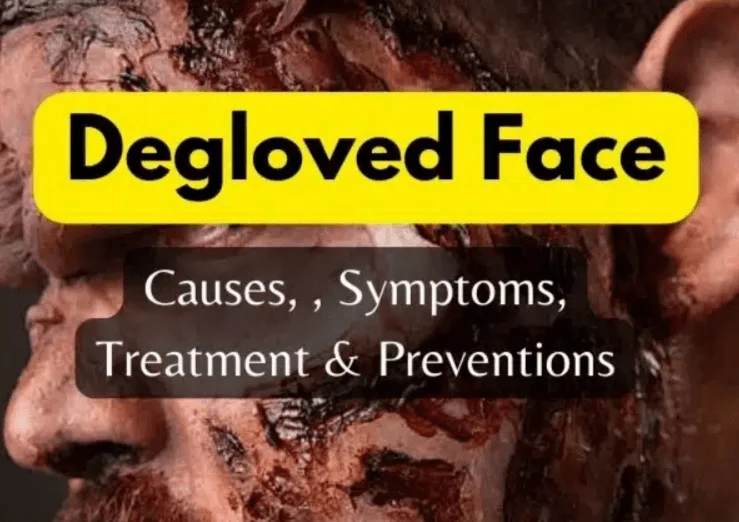
In this comprehensive guide on degloved face injuries, we have covered a wide array of topics crucial for understanding and managing this severe condition. Key points include:
- Causes: Various high-impact events such as car accidents, industrial incidents, and animal attacks can result in a degloved face.
- Symptoms: Immediate signs include extreme pain, visible lacerations, exposed tissues, severe blood loss, and potential necrosis.
- Diagnosis: Early diagnosis using visual examinations and advanced imaging techniques like CT scans and MRI is essential for effective treatment planning.
- Immediate Actions: First aid measures, such as controlling bleeding and seeking emergency medical attention, are critical.
- Treatment Options: Treatment involves emergency stabilization, surgical interventions, infection prevention, and pain management.
- Surgical Procedures: Detailed procedures include debridement, reattachment of tissues, use of skin grafts and flaps, and staged surgeries for long-term reconstruction.
- Recovery Process: Recovery involves a structured timeline with physical therapy, regular follow-ups, and psychological support.
- Potential Complications: Managing complications like infections, necrosis, scarring, and nerve damage requires vigilant medical care.
- Long-Term Outlook: Reconstructive surgery plays a significant role in improving both appearance and function, while ongoing support systems enhance the quality of life.
- Real-Life Case Studies: Examples highlight different treatment approaches and outcomes, providing valuable insights and lessons learned.
- Prevention: Safety measures such as wearing protective gear, adhering to workplace protocols, practicing safe driving, and avoiding risky behaviors can prevent degloved face injuries.
- FAQs: Common questions address immediate actions, recovery time, prevention strategies, and the types of support needed during recovery.
Emphasizing the importance of early treatment and comprehensive care, it is crucial for individuals and families affected by a degloved face to seek prompt medical advice and ongoing support. Recovery is a multifaceted journey that benefits greatly from a well-coordinated approach involving medical, physical, and psychological care.
By understanding the complexities of a degloved face, patients and their support systems can better navigate the path to recovery, ensuring the best possible outcomes and improving overall quality of life.
Read Also:
-
Coughing Up Yellow Mucus? – Understand These 5 Phlegm Colors, Their Causes, and Treatment Options
-
10 Proven Tips to Manage Stomach Flu Effectively: Essential Information and Symptoms Guide
-
Say Goodbye to Sciatic Nerve Pain in Just 10 Minutes With This Natural Method: A Step-by-Step Guide
-
5 Essential Tips for Popping Hidden Tonsil Stones: A Guide to Relief and Prevention
Call to Action
If you found this article on degloved face injuries informative and helpful, please consider sharing it with others who might benefit from this critical information. Spreading awareness can help more people understand the severity and treatment of such injuries, potentially improving outcomes for those affected.
We invite you to subscribe to our blog for more in-depth articles on related topics, including advanced medical treatments, recovery strategies, and patient support. Stay informed and connected with the latest insights and expert advice in the field of medical care and rehabilitation.
Your health and well-being are our top priorities. Don’t hesitate to reach out for personalized support and guidance on your journey to recovery.
